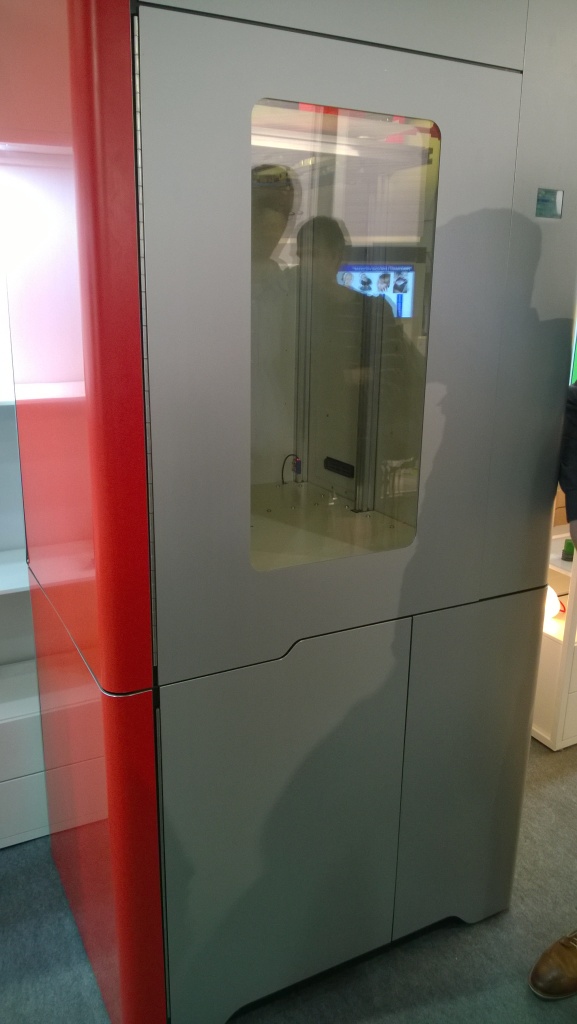Another sunny day here in Hannover.

We went to the fair around ten this morning, and I started from halls 1 and 2. Mostly filled with IBM and other very large companies, but it was interesting nevertheless. IBM was trying to get back into academic co-operation (apparently Microsoft has ousted them from the close relationship they had previously, so my business card was hot stuff). IBM as always laid on a huge show, this time they had almost half a hall with gigantic watercooled hardware as well as artistic expertise:

But as you can see, it has the Big Data flair. The art was created by multiple artists working on the same virtual canvas at the same time.

IBM also had brought in Watson, its supercomputer-based knowledge system that is reputedly better in diagnosing ailments than your average doctor. They made it work on a multitude of issues, and to me as a linguist, the main interest was in Watson’s handling of real human language. In this image it is shown how Watson handles natural language sentences.

Given that the cloud processing power will make voice commands the prevalent method of interacting with computers, I am very eagerly waiting for applications that will harness the strength of Watson and other such computers.
The second major player in this cavernous hall was Intel. It had brought in a wealth of startups and researchers it was working with, and by far the most interesting was the Proglove. It is a glove for factory workers, equipped with a RFID tag reader and a barcode reader. The system is able to follow the workflow, recognize items that are to be installed and also the tools that are used. If the worker needs an item to install, he no longer needs to use a barcode scanner, merely touching the box will identify whether it is the correct part, and when he grabs a tool, the glove will tell him if it is not the right one for the item.
Partnering seemed to be big in this hall too, as well as Big Data. This system, running on 4 servers configured as one Linux machine, used hard drives to mine through Singapore traffic data (remember they all have mandatory GPS systems in their cars), and with that data predict the traffic patterns an hour or more into the future.

Then there was finally interesting stuff in 3D printing. A Prague based company makes FDM printers, not very special in themselves except for very clean and neat design, but for the size of the print room. The regular version does the normal 15 x 15 x 15 cm, but they have another that can print up to 70 cm tall designs. Two things spring to mind – adhesion to the table, and the structural integrity of the mesh. The tall printer sets you back 21,000 euros, which to me sounds a little harsh.

The designer of the machines also experiments with printing itself, and here he shows a clock that has an inserted cube in the infill, thus making the infill a part of the visual image of the clock.

A little walk away from this stand was a Korean (South) printer shop. Here I saw the first wood filament as well as a bronze filament. The wood filament prints objects that really have a wooden feel, and the bronze statues have a weight totally different from ABS or PLA. If you print with, say, 0.2mm thickness and use a fair amount of infill, the object will feel unlike a printed object, but carved instead.


The printer itself was not very spectacular, apart from its name Marv, short for Marvellous. In fact, there were many types of printers that could have come from the same workshop. Ultimaker clones abound, as well as delta printers. I did see one entirely different method of printing, namely the resin photolithography. This thing looks like a spacecraft compared to the usual FDM printers:

The object is built in a pool of resin by light tracing the outlines. The build process therefore happens upside down as compared to the regular methods. The smell is quite strong, but the resolution of the object is good. In fact, this was one of the highlights of the whole trip so far.
I will conclude this day’s report with a triplet of mean-looking remote-control helicopters. I thought the Turkish looked mean, until I found the Chinese one, which then paled when the German hotrod appeared. The last one can lift an entire SLR camera and keep it airborne for quite some time.



And hey – if you ever wondered what is the equivalent of a BMW 750i car in the world of showers, look no further (for the life of me I can’t figure out a good use for this phone app-controlled showering system):
Let’s see what tomorrow will bring. At least I will return to Hall 8, where the students show their projects.
![]()